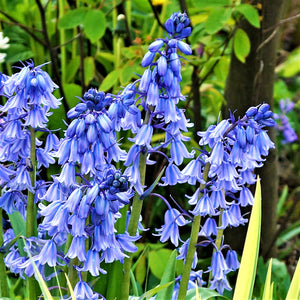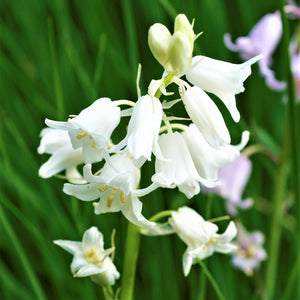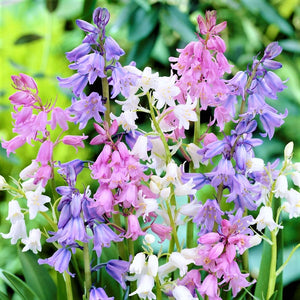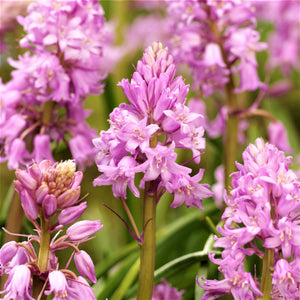- Home
- Planting Guides
- Spanish Bluebells (Hyacinthoides) Planting & Growing Guide
Spanish Bluebells (Hyacinthoides) Planting & Growing Guide
Exceptionally easy to grow and even easier to look at, Spanish Bluebells or Hyacinthoides, produce pastel bell-shaped flowers that elegantly hang from strong stalks. They’ll gladly bloom in full sun to dappled shade and thrive in garden beds, rock gardens, or patio containers. Not to mention, hungry deer and rabbits seem to be the only ones immune to the charm of these delightful blooms, as butterflies and hummingbirds can't get enough! So, are you ready to grow your own? Get all the dirt on planting and caring for Spanish Bluebells with this stellar growing guide!
Success Snapshot
PLANTING
DEPTH
3-4"

WATER
QUANTITY
Moderate
SUNLIGHT
QUANTITY
Partial Sun to Partial Shade
PLANTING
PROXIMITY
4-6" Apart
BLOOM
SEASON
Spring
HARDINESS
ZONES
Zones 3-8
Shop Related Products

Spanish Bluebells - Hyacinthoides Blue
$5.95
Contains: 10 Hyacinthoides bulbs
Botanical Name: Hyacinthoides hispanica, syn. Scilla campanulata, Scilla hispanica
Exposure: Partial Sun to Partial Shade
Hardiness: Zones 3-8

Spanish Bluebells - Hyacinthoides White
$5.95
Contains: 10 Hyacinthoides bulbs
Botanical Name: Hyacinthoides hispanica 'White', syn. Scilla campanulata, Scilla hispanica
Exposure: Partial Sun to Partial Shade
Hardiness: Zones 3-8

Spanish Bluebells - Hyacinthoides Mix
$10.95
Contains: 30 Hyacinthoides bulbs mixed
Botanical Name: Hyacinthoides hispanica, syn. Scilla campanulata, Scilla hispanica
Exposure: Partial Sun to Partial Shade
Hardiness: Zones 3-8

Spanish Bluebells - Hyacinthoides Pink
$5.95
Contains: 10 Hyacinthoides bulbs
Botanical Name: Hyacinthoides hispanica 'Pink', syn. Scilla campanulata, Scilla hispanica
Exposure: Partial Sun to Partial Shade
Hardiness: Zones 3-8
Where to Plant
Spanish Bluebells are super easy to grow in both containers and outdoor gardens, fancying little more than well-drained soil. They thrive in a variety of light conditions, ranging from full sun to partial shade to dappled shade. If you notice puddles of water 5–6 hours after a hard rain, scout out another site or amend the soil with organic material to raise the level 2–3 inches.
When to Plant
As with many other spring-blooming bulbs, Spanish Bluebells should be planted around early to mid-fall, after the soil has cooled down a bit. Roots will form shortly after in the fall, with leaves and flowers developing in the spring.
How to Plant
- For outdoor landscape planting, find a spot where the soil drains well, and your Spanish Bluebells will receive good light. Dig holes and plant the bulbs 4" apart and 4" deep with the pointy ends facing up.
- For container planting, start with good quality, well-draining potting soil and tall or shallow containers with adequate drainage holes. Dig holes and plant the bulbs 2–3" apart and 4" deep with the pointy ends facing up.
- Water thoroughly, soaking the soil to settle it around the bulbs.
How to Grow
- Water as needed during active growth periods, with about 1" of moisture per week as a rough estimate.
- Leave the foliage in place after blooming has finished for the season. The leaves will gather sunlight to create food through photosynthesis, strengthening the bulb for the future.
- Remove the dry foliage when the leaves turn yellow and die back as the plants slip into dormancy around early to mid-summer.
- Allow your Spanish Bluebells to rest for a few months before beginning their next growing cycle.
Spanish Bluebells Tips & Tricks
- Amend the soil with ground bark, decomposed manure, or compost to improve drainage and encourage a healthy start.
- Bear in mind that Spanish Bluebells are more forgiving of poor soil than most plants, and once established, they'll even perform nicely in dry shade!
- Feel free to snip flowers for colorful bouquets when in bloom, as doing so will not hurt the plants.
- Plan to leave your Spanish Bluebell bulbs in place for several seasons, as they prefer not to be moved.
- Mix your Spanish Bluebells with Daffodil varieties that perform well in both cold and warm climates, such as Golden Bells or Ice Follies. Asiatic Lilies and low-growing types of Oxalis are also fantastic options.




